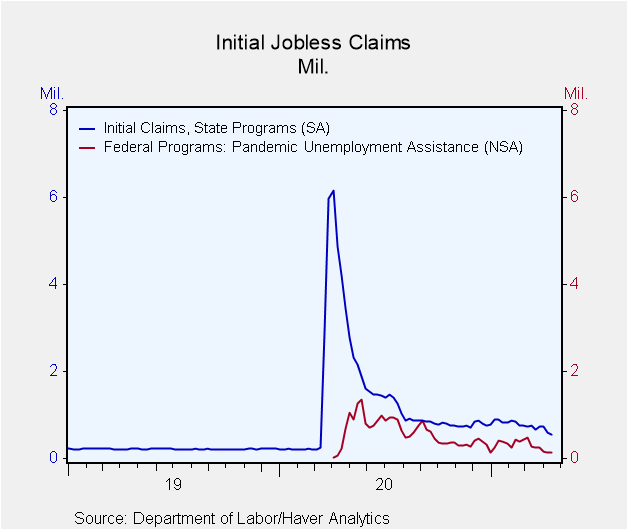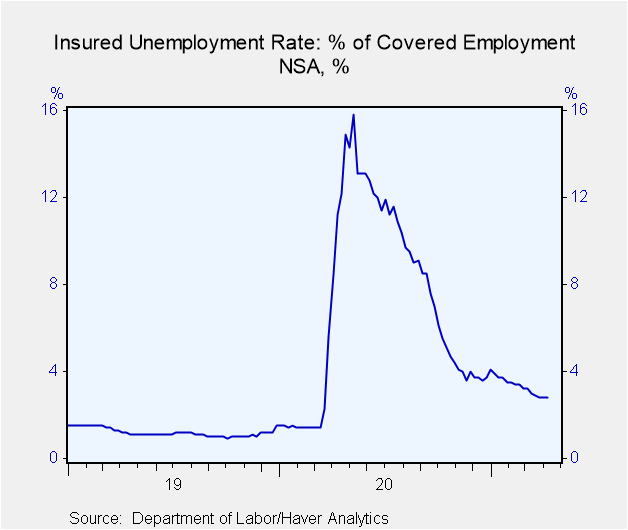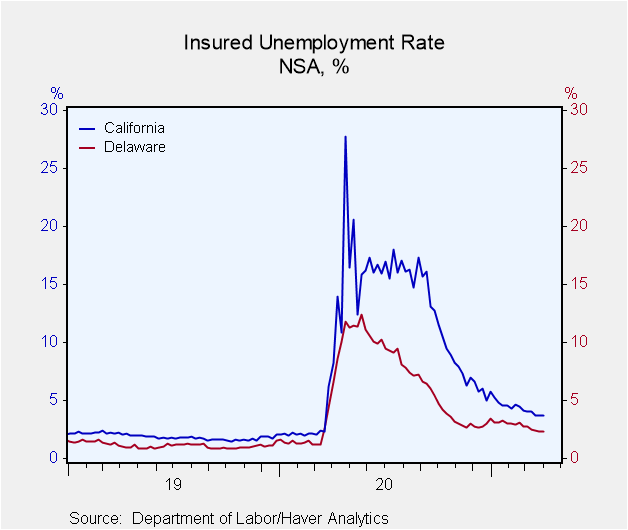 Global| Apr 22 2021
Global| Apr 22 2021U.S. Initial Jobless Claims Fall Again to a New Pandemic-Period Low
Summary
• Initial claims in PUA program edge up, but are still low. • Continuing claims decrease, and rate eases back to pandemic low. • Continuing claims for PUA and PEUC benefits both increase. Initial claims for unemployment insurance [...]
• Initial claims in PUA program edge up, but are still low.
• Continuing claims decrease, and rate eases back to pandemic low.
• Continuing claims for PUA and PEUC benefits both increase.
Initial claims for unemployment insurance decreased again in the week ending April 17, reaching 547,000, down 39,000 from the prior week's 586,000. That reflected a modest upward revision from 576,000 initially reported, which was a weekly decline of 193,000. After that decline, the Action Economics Forecast Survey panel expected a rebound to 625,000, so this latest week is notably lower than expected. The latest week's 547,000 represents yet another new low since the pandemic started in March 2020, even though it is still well above pre-pandemic amounts. The 4-week moving average is 651,000 in the period ending April 17, down from 678,750 the week before.
Initial claims for the federal Pandemic Unemployment Assistance (PUA) program edged slightly higher in the April 17 week, reaching 133,319, up from 131,721 the week before. Still, these are both the smallest since April 11, 2020, right after the program started. The PUA program covers individuals such as the self-employed who are not included in regular state unemployment insurance. Given the brief history of this program, these and other COVID-related series are not seasonally adjusted.
Continuing claims for regular state unemployment insurance decreased 34,000 in the week ended April 10 to 3.674 million from 3.708 million in the April 3 week; that earlier week was revised down from 3.731 million. The state insured rate of unemployment eased back to 2.6% from the previous week's 2.7%. The 2.6% rate is also the lowest since the pandemic started; it was as high as 15.9% in May 2020.
Continuing PUA claims turned higher in the April 3 week, climbing to 7.310 million from the prior week's 7.044 million. Still, these last two week are the lowest since the first few weeks of the pandemic period, except for a dip during the Christmas-New Year's week. Also in the April 3 week, the number of Pandemic Emergency Unemployment Compensation (PEUC) claims rose, reaching 5.606 million, up from 5.158 million in the prior week. That program covers people who were unemployed before COVID but exhausted their state benefits. Extended PEUC benefits, which were included in the American Rescue Plan bill, totaled 492,999.
The total number of all state, federal, and PUA and PEUC continuing claims rose to 17.405 million, up 491,674 on the week. The last two weeks are also the lowest since very early in the pandemic period, except for that holiday week in January. This grand total is also not seasonally adjusted.
The state insured rates of unemployment continued to vary widely. In the week ending April 3, the highest insured unemployment rates were in Nevada (5.59%), Connecticut (5.15%), Alaska (5.05%), New York (4.38%) and Illinois (4.23%). The lowest rates were in Kansas (0.70%), South Dakota (0.77%), Utah (0.84%), Nebraska (1.01%) and Alabama (0.87%). Insured unemployment rates in other large states included California (3.66%), Texas (2.31%) and Florida (1.55%). These state rates are not seasonally adjusted.
Data on weekly unemployment claims going back to 1967 are contained in Haver's WEEKLY database, and they are summarized monthly in USECON. Data for individual states are in REGIONW. The expectations figure is from the Action Economics Forecast Survey, carried in the AS1REPNA database.
| Unemployment Insurance (SA, 000s) | 04/17/21 | 04/10/21 | 04/03/21 | Y/Y % | 2020 | 2019 | 2018 |
|---|---|---|---|---|---|---|---|
| Initial Claims | 547 | 586 | 742 | -87 | 1,352 | 218 | 220 |
| Initial Claims (NSA) | 566 | 623 | 739 | -87 | 1,353 | 218 | 221 |
| Initial Claims Pandemic Unemployment Assistance (NSA) | 133 | 132 | 152 | -- | -- | -- | -- |
| Continuing Claims | -- | 3,674 | 3,708 | -77 | 10,380 | 1,699 | 1,754 |
| Continuing Claims (NSA) | -- | 3,863 | 3,914 | -76 | 10,370 | 1,704 | 1,763 |
| Continuing Claims Pandemic Unemployment Assistance (NSA) | -- | -- | 7,310 | -- | -- | -- | -- |
| Insured Unemployment Rate (%) | 2.6 | 2.7 |
12.4 |
7.1 | 1.2 | 1.2 |
Carol Stone, CBE
AuthorMore in Author Profile »Carol Stone, CBE came to Haver Analytics in 2003 following more than 35 years as a financial market economist at major Wall Street financial institutions, most especially Merrill Lynch and Nomura Securities. She has broad experience in analysis and forecasting of flow-of-funds accounts, the federal budget and Federal Reserve operations. At Nomura Securites, among other duties, she developed various indicator forecasting tools and edited a daily global publication produced in London and New York for readers in Tokyo. At Haver Analytics, Carol is a member of the Research Department, aiding database managers with research and documentation efforts, as well as posting commentary on select economic reports. In addition, she conducts Ways-of-the-World, a blog on economic issues for an Episcopal-Church-affiliated website, The Geranium Farm. During her career, Carol served as an officer of the Money Marketeers and the Downtown Economists Club. She has a PhD from NYU's Stern School of Business. She lives in Brooklyn, New York, and has a weekend home on Long Island.









